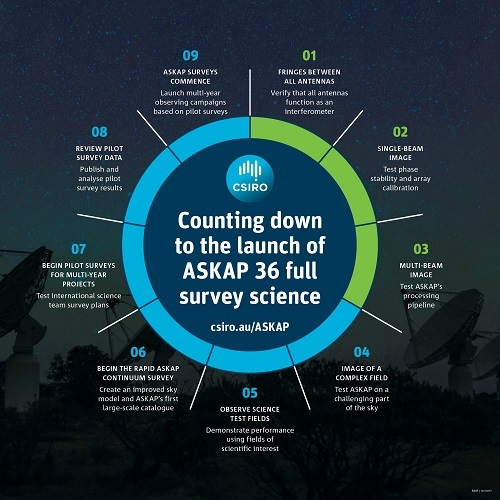Counting down to the launch of ASKAP 36 full survey science, Stage 3, first multi-beam image with the full ASKAP array.

The countdown to ASKAP 36 full survey survey science is a campaign designed to share ASKAP's final commissioning sequence with the community, in the lead-up to full operations. As you might imagine, the process of bringing to life such a complex science instrument doesn't provide a single moment of victory but rather a series of exciting steps, building towards full capability. The nine stages on the countdown, show a sequence of increasingly complex operations. The milestones are being produced in turn by the ASKAP Survey Science Teams or CSIRO staff.
ASKAP's latest wide-field image demonstrates the full power of a survey telescope
Today's reveal of the 3rd milestone, shows the first public release of images and data from a field observed with all antennas and beams. As part of the ongoing campaign to prepare for large-scale surveys, CSIRO's ASKAP operations team recently observed a region known as the GAMA 23 field. GAMA stands for Galaxy And Mass Assembly, which is the name of a multi-wavelength project designed to study the structure of galaxy groups in order to better understand how they formed.
Background to the GAMA Project
The GAMA project includes an optical astronomy survey completed several years ago using the Anglo-Australian Telescope (AAT) at Siding Spring Observatory. The AAT was used to measure the red-shift of galaxies within the GAMA fields, giving astronomers a measure of their velocity and distance. While optical telescopes can see starlight from a galaxy, radio telescopes like ASKAP detect the neutral hydrogen gas from which stars form, and the energetic emission from active galactic nuclei. Combining radio and optical images therefore provides a more complete picture for astronomers to study.
Demonstrating next-gen capabilities with ASKAP
For our first multi-beam observation with all of ASKAP's antennas we decided to take a quick look at the GAMA 23 field as a preview of the exciting results to come. This particular field is a good candidate for observations with ASKAP because it is relatively free from bright radio sources that may drown out the faint galaxies we hope to study.
"The GAMA 23 field covers about the same area as your fist held up at arm's length. With ASKAP's 36 beams acting like an insect's compound eye we can image 30 square degrees at a time, so only two observations (each 8-hours long) were needed to cover the whole region at a central frequency of 888 MHz," said ASKAP Project Scientist, Dr Aidan Hotan. "The resulting image contains thousands of radio galaxies and has roughly 215 mega-pixels, making it very difficult to display on a typical computer monitor," he said. To help with this, we have created an interactive version that you can zoom and pan through online:
http://www.atnf.csiro.au/projects/askap/askap-G23.html
Most of the bright spots in the image are radio galaxies located far from the Milky Way. Optical spectroscopy shows that some of these galaxies are roughly one billion light years away! While the most distant galaxies appear only as unresolved dots, many of the galaxies in the ASKAP image show extended structure. This often takes the form of jets and lobes that we think emerge from material surrounding the super-massive black hole at the centre of each galaxy. One of the best such examples is a giant radio galaxy that can be found at coordinates RA = 22:53:36, Dec = -34:55:28, as shown below. (See if you can find it in the interactive image?)

Radio galaxies often have roughly symmetric lobes on either side of a central bright spot (like the one above), but some display highly unusual shapes like the one shown below (RA = 23:13:42, Dec = -30:54:26 in the interactive image). Discovering more of these unusual galaxies and studying their properties helps us understand the events (such as collisions between two or more galaxies) that can take place in galaxy clusters.

Global importance of this freely available ASKAP data-set
The primary purpose of this data release is to give astronomers across the world a chance to see how ASKAP will perform when large-scale surveys begin. These observations will be compared to results from other observatories to make sure that the telescope is producing accurate data. However, we hope that the new image will also improve our understanding of the GAMA 23 field and its many galaxies.
ASKAP's EMU (Evolutionary Map of the Universe) survey science project will use these new observations to see how close early predictions of ASKAP's performance were to its current capabilities. The DINGO (Deep Investigations of Neutral Gas Origins) survey science project will use ASKAP to conduct deep spectroscopic observations of the GAMA fields over the next few years, so these new images will also help plan for the future.
Anyone interested in accessing the data can do so via the CSIRO ASKAP Science Data Archive, CASDA.
